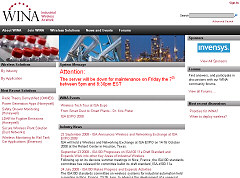 1. Capacitive Sensor Tutorial
1. Capacitive Sensor Tutorial
For an excellent, thorough discussion of what capacitive sensing is, how it works, and how to make it work as well as possible in your application, I would suggest a visit to Lion Precision's online capacitive sensor tutorial. You'll find information on what capacitance is and how it's measured; how targets affect your measurements (and how to make that work in your favor); and how to maximize accuracy as well as definitions of sensitivity, various types of errors, bandwidth, and resolution.
 2. Wireless Networking Site
2. Wireless Networking Site
WINA, the Wireless Industrial Networking Alliance, is an entity devoted to spreading information about wireless sensor networking in a clear, vendor-neutral way. It gathers together members from industry and academia as well as end users. If you're looking for information on wireless sensor networking, then check the newly revamped Web site to find out about upcoming wireless events and webinars, download white papers, and participate in the various online forums.
 3. A Blog (and Podcast) About the Economy
3. A Blog (and Podcast) About the Economy
If you're interested in learning more about what's happening in the economy at the moment, I'd like to recommend NPR's Planet Money blog and podcast. Both are updated every day and the podcasts are 15 to 20 min. discussions about some aspect of the current global economic freak-out, often with explanations from a variety of economists and other experts. It is always educational, frequently mind-boggling, and occasionally terrifying.
New to Bookshelves
 Nanotechnology-Enabled Sensors
Nanotechnology-Enabled Sensors
Author: Kourosh Kalantar-zadeh and Benjamin Fry
Publisher: Springer
ISBN: 978-0-387-32473-9
Page count: 490
This hardcover book is aimed squarely at researchers and graduate students who want to understand nanotechnology-enabled sensors. The authors' intent is to provide this audience with sufficient information so that they can develop these devices.
The book is divided into seven chapters. The first introduces nanotechnology, sensors, and nanotechnology-enabled sensors. The second chapter, Sensor Characteristics and Physical Effects, covers a great deal of territory as it discusses basic sensor characteristics and terminology and then provides brief descriptions of the various physical effects that are used to give sensors their sensing ability. Chapter three, Transduction Platforms, details the basic methods used to create a transducer and focuses on those fabricated using micro/nanofabrication processes. Chapter four, Nano Fabrication and Patterning Techniques, talks about synthesizing various types of nanoparticles, thin-film formation, and other fabrication methods. Chapter five, Characterization Techniques for Nanomaterials covers the various microscopy, spectroscopy, spectrometry, and diffraction technologies used to assess the materials and structures involved. Chapter six (Inorganic Nanotechnology Enabled Sensors) and Chapter seven (Organic Nanotechnology Enabled Sensors) discuss how nanomaterials are used in sensing applications.
The book is written by researchers for researchers, so the text is dry but packed with information and it is supported by a wealth of diagrams and photographs. In addition, the extensive lists of references at the end of each chapter allow you to seek out the books and articles required to round out your understanding of the topics discussed.